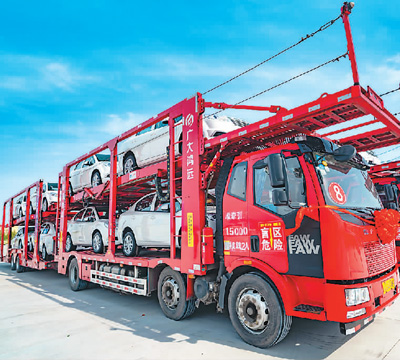(Peoples Daily Online)09:08, July 01, 2020![]()
Chinese automaker SAIC Motor Corporation held the “cloud opening ceremony” for the first flagship store of its MG model in Paris recently, as part of Chinese auto companies efforts to improve the competitiveness of their brands, and stabilize and expand overseas markets.

200 electric vehicles manufactured by Henan Suda Electric Vehicle Technology Co., Ltd. are ready to be exported to Dusseldorf, Germany. (Photo/Peoples Daily)
The store has met with more than 270 French media and consumers via online video. In just half a day after the cloud opening ceremony, the social media account MG Motor Paris has attracted nearly 10,000 fans.
In recent years, the Belt and Road initiative has provided Chinese auto brands with new opportunities to expand their markets abroad. Among them, SAIC Motor Corporation, the leading automobile export enterprise, has made its presence in more than 60 countries and regions around the world, forming the whole automobile industry chain covering research and development, manufacturing, marketing, logistics and finance.
A representative of SAIC Motor Corporation said that SAIC has set up three overseas innovative RD centers in the UK and other countries, three auto manufacturing bases in Thailand, Indonesia and India, and 95 parts manufacturing bases overseas.
Meanwhile, it has set up 12 regional marketing service centers in Europe, South America, Africa, the Middle East, Australia and New Zealand, and more than 600 overseas marketing service outlets around the world. The first overseas financial service company was established in Indonesia.
For every three Chinese cars sold overseas, one is made by SAIC, according to the representative of SAIC, adding that SAIC exported 350,000 automobiles in 2019, an increase of 26.5 percent over the same period last year.
SAIC only serves as a typical example. With the continuous promotion of the Belt and Road Initiative and the further recovery of the international market, Chinas automobile exports to countries along the Belt and Road will continue to expand.
Chongqing, an important automobile production base in Southwest China, exported 23,000 vehicles to countries along the Belt and Road from January to May, valued at 1.7 billion yuan (about 240 million U.S. dollars), up 48.6 percent and 84.6 percent respectively over the same period last year, according to a news release from Chongqing Commerce Commission on June 23.
As the pandemic in some foreign countries has gradually waned, commercial activities have gradually been resumed, and orders in overseas markets are recovering, said a relevant person from Chongqing Commerce Commission, adding that most auto companies are confident that they can stabilize overseas markets by investing in new products, innovating marketing models, and strengthening sales promotion.
